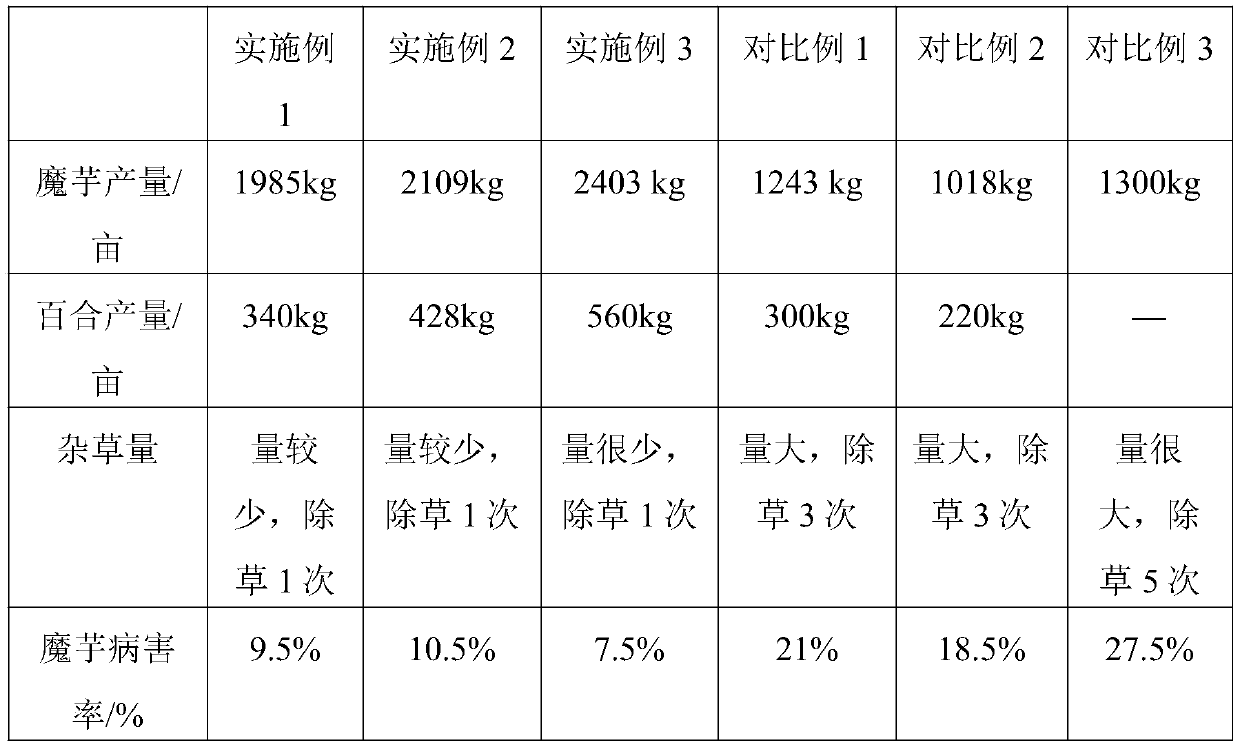Cultivation method of intercropping konjac and lilies
A cultivation method and technology of konjac, applied in root crop cultivation, bulb cultivation, etc., can solve problems such as herbicide side effects, human injury, environmental pollution, etc., and achieve the effects of reducing pollution, reducing land rent, and reducing economic losses
- Summary
- Abstract
- Description
- Claims
- Application Information
AI Technical Summary
Problems solved by technology
Method used
Image
Examples
Embodiment 1
[0040] (1) Site selection
[0041] It is advisable to choose half-shady and half-sun slopes and mountain valleys that are leeward to the sun, easy to drain and irrigate, and have good lighting conditions but no strong sunlight. The soil is deep, loose and fertile, rich in organic matter and humus, acidic, and easy to drain. Sandy loam, avoid plots that have recently been planted with konjac or lilies (i.e. crop rotation).
[0042] (2) Land preparation
[0043] At the end of February and the beginning of March, the pre-planted land was deeply plowed, sun-dried, and finely plowed. Use 2000kg of fully decomposed farmyard manure and 20kg of nitrogen, phosphorus and potassium compound fertilizer per mu to mix evenly and apply it on the soil surface. Deep plow 30cm, and use 1500cm Moisture surface wide ridges, ridge height 20cm, ditch width 35cm.
[0044] (3) Selection
[0045] Konjac taro is a new variety with strong disease resistance, Jindi No. 1. Its appearance is round or ov...
Embodiment 2
[0056] (1) Site selection
[0057] It is advisable to choose half-shady and half-sun slopes and mountain valleys that are leeward to the sun, easy to drain and irrigate, and have good lighting conditions but no strong sunlight. The soil is deep, loose and fertile, rich in organic matter and humus, acidic, and easy to drain. Sandy loam, avoid plots that have recently been planted with konjac or lilies (i.e. crop rotation).
[0058] (2) Land preparation
[0059] At the end of February and the beginning of March, the pre-planted land was deeply plowed, sun-dried, and finely plowed. Use 2000kg of fully decomposed farmyard manure and 20kg of nitrogen, phosphorus and potassium compound fertilizer per mu to mix evenly and apply it on the soil surface. Deep plow 30cm, and use 1500cm Moisture surface wide ridges, ridge height 25cm, ditch width 30cm.
[0060] (3) Selection
[0061] Konjac taro is a new variety with strong disease resistance, Jindi No. 1. Its appearance is round or ov...
Embodiment 3
[0072] (1) Site selection
[0073] It is advisable to choose half-shady and half-sun slopes and mountain valleys that are leeward to the sun, easy to drain and irrigate, and have good lighting conditions but no strong sunlight. The soil is deep, loose and fertile, rich in organic matter and humus, acidic, and easy to drain. Sandy loam, avoid plots that have recently been planted with konjac or lilies (i.e. crop rotation).
[0074] (2) Land preparation
[0075] At the end of February and the beginning of March, the pre-planted land was deeply plowed, sun-dried, and finely plowed. 2000kg of fully decomposed farmyard manure and 20kg of nitrogen, phosphorus and potassium compound fertilizer were evenly mixed per mu and applied to the soil surface. Deep plowing was 35cm, and 1500cm Moisture surface wide ridges, ridge height 30cm, ditch width 35cm.
[0076] (3) Selection
[0077] Konjac taro is a new variety with strong disease resistance, Jindi No. 1. Its appearance is round or ...
PUM
 Login to View More
Login to View More Abstract
Description
Claims
Application Information
 Login to View More
Login to View More - R&D
- Intellectual Property
- Life Sciences
- Materials
- Tech Scout
- Unparalleled Data Quality
- Higher Quality Content
- 60% Fewer Hallucinations
Browse by: Latest US Patents, China's latest patents, Technical Efficacy Thesaurus, Application Domain, Technology Topic, Popular Technical Reports.
© 2025 PatSnap. All rights reserved.Legal|Privacy policy|Modern Slavery Act Transparency Statement|Sitemap|About US| Contact US: help@patsnap.com


